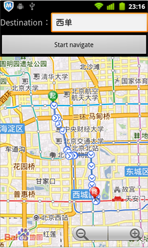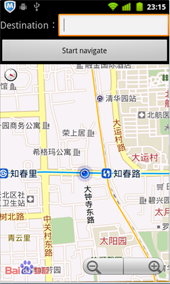今天無(wú)意中看到技術(shù)大神利用百度地圖定位并實(shí)現(xiàn)目的地導(dǎo)航的Demo。覺(jué)得很不錯(cuò),就轉(zhuǎn)載過(guò)來(lái)一起分享,下面我們看實(shí)現(xiàn)效果:


進(jìn)入后首先會(huì)得到當(dāng)前位置,在地圖上顯示出來(lái),在輸入框中輸入目的地后,就會(huì)在地圖上出現(xiàn)最佳線路,我這里設(shè)置的是距離最小的駕車(chē)線路,另外還有公交線路、步行線路,在代碼中都有詳細(xì)注釋。另外,在控制臺(tái)還輸出了線路上每一個(gè)節(jié)點(diǎn)的信息以及起始位置和目的地的距離,信息顯示的是在當(dāng)前節(jié)點(diǎn)的導(dǎo)航信息。如下圖:

接下來(lái)就看如何實(shí)現(xiàn)了,首先,注冊(cè)百度開(kāi)發(fā)者賬號(hào),并進(jìn)入百度地圖API查看相關(guān)資料百度地圖API,然后就是為需要加入地圖的應(yīng)用注冊(cè)APP KEY,注冊(cè)完后,下載百度地圖jar文件,新建工程,并導(dǎo)入即可,下面看實(shí)現(xiàn)具體代碼,在代碼中有詳細(xì)注釋:
public class NavigationDemoActivity extends MapActivity { private String mMapKey = "注冊(cè)自己的key"; private EditText destinationEditText = null; private Button startNaviButton = null; private MapView mapView = null; private BMapManager mMapManager = null; private MyLocationOverlay myLocationOverlay = null; //onResume時(shí)注冊(cè)此listener,onPause時(shí)需要Remove,注意此listener不是Android自帶的,是百度API中的 private LocationListener locationListener; private MKSearch searchModel; GeoPoint pt; @Override public void onCreate(Bundle savedInstanceState) { super.onCreate(savedInstanceState); requestWindowFeature(Window.FEATURE_NO_TITLE); setContentView(R.layout.main); destinationEditText = (EditText) this.findViewById(R.id.et_destination); startNaviButton = (Button) this.findViewById(R.id.btn_navi); mMapManager = new BMapManager(getApplication()); mMapManager.init(mMapKey, new MyGeneralListener()); super.initMapActivity(mMapManager); mapView = (MapView) this.findViewById(R.id.bmapsView); //設(shè)置啟用內(nèi)置的縮放控件 mapView.setBuiltInZoomControls(true); //設(shè)置在縮放動(dòng)畫(huà)過(guò)程中也顯示overlay,默認(rèn)為不繪制 // mapView.setDrawOverlayWhenZooming(true); //獲取當(dāng)前位置層 myLocationOverlay = new MyLocationOverlay(this, mapView); //將當(dāng)前位置的層添加到地圖底層中 mapView.getOverlays().add(myLocationOverlay); // 注冊(cè)定位事件 locationListener = new LocationListener(){ @Override public void onLocationChanged(Location location) { if (location != null){ //生成GEO類型坐標(biāo)并在地圖上定位到該坐標(biāo)標(biāo)示的地點(diǎn) pt = new GeoPoint((int)(location.getLatitude()*1e6), (int)(location.getLongitude()*1e6)); // System.out.println("---"+location.getLatitude() +":"+location.getLongitude()); mapView.getController().animateTo(pt); } } }; //初始化搜索模塊 searchModel = new MKSearch(); //設(shè)置路線策略為最短距離 searchModel.setDrivingPolicy(MKSearch.ECAR_DIS_FIRST); searchModel.init(mMapManager, new MKSearchListener() { //獲取駕車(chē)路線回調(diào)方法 @Override public void onGetDrivingRouteResult(MKDrivingRouteResult res, int error) { // 錯(cuò)誤號(hào)可參考MKEvent中的定義 if (error != 0 || res == null) { Toast.makeText(NavigationDemoActivity.this, "抱歉,未找到結(jié)果", Toast.LENGTH_SHORT).show(); return; } RouteOverlay routeOverlay = new RouteOverlay(NavigationDemoActivity.this, mapView); // 此處僅展示一個(gè)方案作為示例 MKRoute route = res.getPlan(0).getRoute(0); int distanceM = route.getDistance(); String distanceKm = String.valueOf(distanceM / 1000) +"."+String.valueOf(distanceM % 1000); System.out.println("距離:"+distanceKm+"公里---節(jié)點(diǎn)數(shù)量:"+route.getNumSteps()); for (int i = 0; i < route.getNumSteps(); i++) { MKStep step = route.getStep(i); System.out.println("節(jié)點(diǎn)信息:"+step.getContent()); } routeOverlay.setData(route); mapView.getOverlays().clear(); mapView.getOverlays().add(routeOverlay); mapView.invalidate(); mapView.getController().animateTo(res.getStart().pt); } //以下兩種方式和上面的駕車(chē)方案實(shí)現(xiàn)方法一樣 @Override public void onGetWalkingRouteResult(MKWalkingRouteResult res, int error) { //獲取步行路線 } @Override public void onGetTransitRouteResult(MKTransitRouteResult arg0, int arg1) { //獲取公交線路 } @Override public void onGetBusDetailResult(MKBusLineResult arg0, int arg1) { } @Override public void onGetAddrResult(MKAddrInfo arg0, int arg1) { } @Override public void onGetSuggestionResult(MKSuggestionResult arg0, int arg1) { } @Override public void onGetPoiResult(MKPoiResult arg0, int arg1, int arg2) { } }); startNaviButton.setOnClickListener(new OnClickListener() { @Override public void onClick(View v) { String destination = destinationEditText.getText().toString(); //設(shè)置起始地(當(dāng)前位置) MKPlanNode startNode = new MKPlanNode(); startNode.pt = pt; //設(shè)置目的地 MKPlanNode endNode = new MKPlanNode(); endNode.name = destination; //展開(kāi)搜索的城市 String city = getResources().getString(R.string.beijing); // System.out.println("----"+city+"---"+destination+"---"+pt); searchModel.drivingSearch(city, startNode, city, endNode); //步行路線 // searchModel.walkingSearch(city, startNode, city, endNode); //公交路線 // searchModel.transitSearch(city, startNode, endNode); } }); } @Override protected void onResume() { mMapManager.getLocationManager().requestLocationUpdates(locationListener); myLocationOverlay.enableMyLocation(); myLocationOverlay.enableCompass(); // 打開(kāi)指南針 mMapManager.start(); super.onResume(); } @Override protected void onPause() { mMapManager.getLocationManager().removeUpdates(locationListener); myLocationOverlay.disableMyLocation();//顯示當(dāng)前位置 myLocationOverlay.disableCompass(); // 關(guān)閉指南針 mMapManager.stop(); super.onPause(); } @Override protected boolean isRouteDisplayed() { // TODO Auto-generated method stub return false; } // 常用事件監(jiān)聽(tīng),用來(lái)處理通常的網(wǎng)絡(luò)錯(cuò)誤,授權(quán)驗(yàn)證錯(cuò)誤等 class MyGeneralListener implements MKGeneralListener { @Override public void onGetNetworkState(int iError) { Log.d("MyGeneralListener", "onGetNetworkState error is "+ iError); Toast.makeText(NavigationDemoActivity.this, "您的網(wǎng)絡(luò)出錯(cuò)啦!", Toast.LENGTH_LONG).show(); } @Override public void onGetPermissionState(int iError) { Log.d("MyGeneralListener", "onGetPermissionState error is "+ iError); if (iError == MKEvent.ERROR_PERMISSION_DENIED) { // 授權(quán)Key錯(cuò)誤: Toast.makeText(NavigationDemoActivity.this, "請(qǐng)?jiān)贐MapApiDemoApp.java文件輸入正確的授權(quán)Key!", Toast.LENGTH_LONG).show(); } } } } 然后是布局文件:
<?xml version="1.0" encoding="utf-8"?> <LinearLayout xmlns:android="http://schemas.android.com/apk/res/android" android:layout_width="fill_parent" android:layout_height="fill_parent" android:orientation="vertical" > <LinearLayout android:layout_width="fill_parent" android:layout_height="wrap_content" android:orientation="horizontal" > <TextView android:layout_width="wrap_content" android:layout_height="wrap_content" android:textSize="18sp" android:text="Destination:" /> <EditText android:id="@+id/et_destination" android:layout_width="fill_parent" android:layout_height="wrap_content" /> </LinearLayout> <Button android:id="@+id/btn_navi" android:layout_width="fill_parent" android:layout_height="wrap_content" android:text="Start navigate"/> <com.baidu.mapapi.MapView android:id="@+id/bmapsView" android:layout_width="fill_parent" android:layout_height="fill_parent" android:clickable="true" /> </LinearLayout>
AndroidMainifest.xml
<?xml version="1.0" encoding="utf-8"?> <manifest xmlns:android="http://schemas.android.com/apk/res/android" package="com.ericssonlabs" android:versionCode="1" android:versionName="1.0" > <uses-sdk android:minSdkVersion="8" /> <uses-permission android:name="android.permission.ACCESS_NETWORK_STATE"></uses-permission> <uses-permission android:name="android.permission.ACCESS_FINE_LOCATION"></uses-permission> <uses-permission android:name="android.permission.INTERNET"></uses-permission> <uses-permission android:name="android.permission.WRITE_EXTERNAL_STORAGE"></uses-permission> <uses-permission android:name="android.permission.ACCESS_WIFI_STATE"></uses-permission> <uses-permission android:name="android.permission.CHANGE_WIFI_STATE"></uses-permission> <uses-permission android:name="android.permission.READ_PHONE_STATE"></uses-permission> <supports-screens android:largeScreens="true" android:normalScreens="true" android:smallScreens="true" android:resizeable="true" android:anyDensity="true"/> <uses-sdk android:minSdkVersion="3"></uses-sdk> <application android:icon="@drawable/ic_launcher" android:label="@string/app_name" > <activity android:name=".NavigationDemoActivity" android:label="@string/app_name" > <intent-filter> <action android:name="android.intent.action.MAIN" /> <category android:name="android.intent.category.LAUNCHER" /> </intent-filter> </activity> </application> </manifest>
上面就是實(shí)現(xiàn)百度地圖定位和目的地的導(dǎo)航的所有代碼啦,不知道是不是你們想要的呢?
以上就是本文的全部?jī)?nèi)容,希望對(duì)大家的學(xué)習(xí)有所幫助,也希望大家多多支持VEVB武林網(wǎng)。
新聞熱點(diǎn)
疑難解答
圖片精選
網(wǎng)友關(guān)注